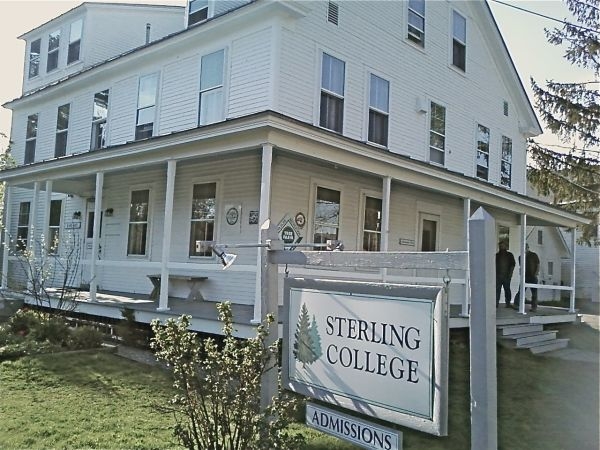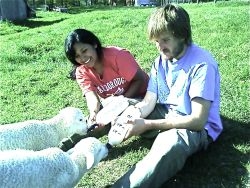
(Host) Sterling College in Craftsbury Common handed diplomas to 27 seniors last Saturday-the largest graduating class in its history.
But this time last year, it was fighting for survival.
VPR’s Charlotte Albright paid a visit on one of the last days in the spring semester to see how the smallest residential liberal arts college in the country is doing.
(Albright) A warm sun shines down on Sterling College on this mid-May afternoon, as an all-school meeting celebrates student achievements.
Classic white clapboard buildings stand tall around Craftsbury Common. Just a few years ago, though, it looked as if all those historic doors might not stay open.
(Will Wootton) "Certainly the biggest surprise, the biggest bad surprise, was a worse financial situation and history than I had imagined."
(Albright) When President Will Wootten took the helm four years ago, the school was running operating deficits as high as 10 percent.
With a hole that big, and only a hundred students, even a slight dip in enrollment can have dire consequences. Wootton convinced lawmakers to hand over $350,000 for a dorm, to house 20 more paying customers.
And he asked some faculty to work year round, so students can attend any term they want.
(Outdoor sounds)
(Albright) Whenever they arrive, they have to bring something most college freshmen don’t need.
(Ned Houston) "I think ours is the only college where students are required to show up with a sharp ax rather than causing consternation because they have one."
(Albright) Ned Houston has taught here for 32 years and is now also Vice President and Director of Financial Aid.
Showing off a table of fiber arts projects in the school’s library, he sums up the school’s progressive philosophy.
(Houston) "It started with faculty who really believed that experience informs theory and theory informs experience and we designed this higher education curriculum with that thought in mind, but it was also place based."
(Albright) By "place-based," Houston means that the college uses its 430 acres not merely as a site for buildings, but as an open-air laboratory for learning.
Majors include sustainable agriculture, natural history and environmental humanities, outdoor education and leadership, and conservation ecology.
 (Sound of animals in the barn)
(Sound of animals in the barn)
Before and after classes, all students must do chores: cleaning dorms, maintaining a wood lot, boiling maple sap, growing vegetables, and feeding animals.
Like the two ravenous baby lambs who follow Junior Maria Burger all over campus, and down to the barn.
(Burger) "These guys had a little cold so we’ve been taking care of them. We’ve been giving them apple cider vinegar, a little bit of yogurt to help settle their stomach and garlic tincture."
(Sound of water running in bucket)
(Albright) Up the hill, another student is hard at work at the campus smithy, making knives.
(Sound of blacksmith hammer)
(Albright) Brian Clift came to Sterling from Eugene, Oregon.
(Clift) "It’s a beautiful place, it’s a great place to be, I get to do things like this, I can blacksmith, I can farm, I can work with horses on a regular basis-you can’t really knock that."
(Albright) But Sterling is also fostering cutting-edge research based on field studies around the world, and throughout Vermont.
(Sound of chimes ringing)
(Albright) As evening chimes ring out of a white church on the Common, students in work pants and Birkenstock sandals file into a spartan wooden building to hear senior Hannah McHardy present her senior thesis.
(Sound of audience)
(Albright) Using a sophisticated power point presentation, McHardy explains how microbes could help clean up now defunct mines on Belvidere Mountain in Eden and Lowell-which contain a toxic kind of asbestos found also in Italy.
(McHardy) "Specifically I wanted to find the verticillium lepto bacteria that they have out in Italy and see if it’s native here too. And if we didn’t find that particular fungi I wanted to know if the fungi that are native here modify that chrysotile fiber and render them amorphous."
(Albright) McHardy says even the EPA was unaware of these new remediation techniques when she called them about her project. By attracting students like her, Sterling aspires to be a place where budding scientists will learn how to sustain the planet.
And Sterling seems to be to sustaining itself. The budget is still not balanced, but summer term enrollment is healthy, and renovations are starting on a newly purchased inn, where Wootton hopes to house 20 students. But he doesn’t want to accept more than 125.
(Wootton) "And growth is the lingua franca-is that the right term? And it’s what people do and I’ve always rejected it, I don’t understand it, I don’t believe in it necessarily. I love the small intimate college, and I think it can be an economic model."
(Albright) But Sterling has a razor thin financial cushion. Its long-range survival plan calls for the endowment to grow from the current $650,000 to $10 million. Last year’s gifts ranged from $5 to $50,000 per donor, and President Wootton hopes to keep them coming.
(Albright) For VPR News, I’m Charlotte Albright in Craftsbury Common.